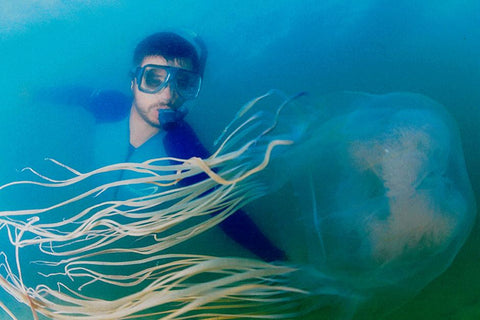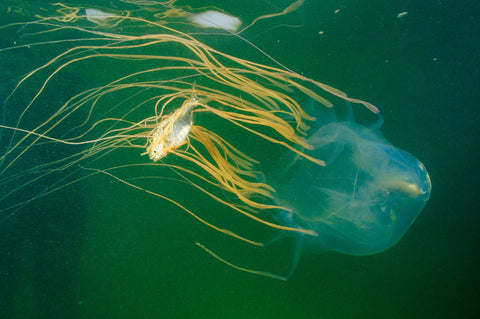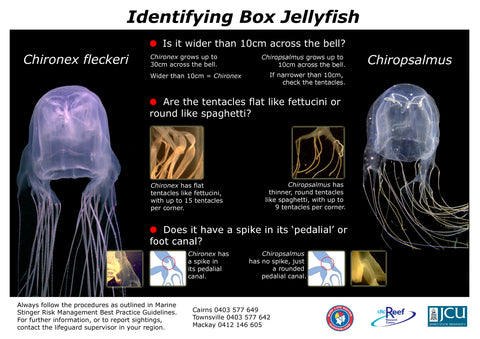Researchers are warning that Jellyfish pose the biggest threat to how we interact with the Ocean.
January 18, 2018 7 min read

It’s been a major talking point in recent years: are the stingers moving south?
It appears that most experts believe they are. Today we’re going to talk about the various kinds of stingers, their impact on humans, Irukandji species and migration as well as the notorious Box Jellyfish and it's behaviour. We'll also talk about how to treat and avoid stings. Australia has had a dense history of stingers, being that we’re water lovers and our tourism industry somewhat revolves around the Great Barrier Reef, however worldwide attention is greatly increasing. This is due to a widespread and prolific increase in jellyfish populations worldwide and considering the map below it's easy to see exactly how prolific this growth is. Topical Medicine expert, Dr Yanagihara, of the University of Hawaii suggest that the 'worldwide explosion of jellyfish populations may be due to impacts of global climate change, our egregious human mismanagement of the oceans and our slaughter of some 70 million sharks yearly.'
Sufferers of Irukandji syndrome report a 'sense of impending of doom'.
I don’t know about you but I'd take sharks any day of the week, at least they can avoid you! Imagine spending 3 days in pain so intense that the maximum administrable dose of morphine doesn’t help, only to come out the other side with chronic heart and neurological damage… Bite my leg off any day thank you!
 New Scientist Journal
New Scientist Journal
Interesting facts about Box Jellyfish, Irukandji and Bluebottles.
- Box Jellyfish kill 20-40 Filipinos annually, in Australia this is less than 1.
- Some species of Box Jellyfish have up to 24 eyes, yet no brain.
- Irukandji reside almost the entire circumference of Australia, with one of the most dangerous species found as far south as Perth [Malo Kingi, although the jury is out on the rate of Irukandji Syndrome infliction, suggesting incorrect identification may be the reason we perceive them as dangerous.]
- Irukandji is a type of Box Jellyfish, when people say a ‘Box Jellyfish’ they’re referring to Chironex Fleckeri.
- There are over 10 different Irukandji varities known to have stung in the waters of Australia, but not of all are confirmed to inflict Irukandji Syndrome.
- Bluebottles are made up of 13 individual creatures.
*in this blog, when we refer to Box Jellyfish we are referring to the Chironex Fleckeri and when we say Irukandji we’re referring to the greater family of Irukandji (excluding Chironex Fleckeri)unless we specifically mention their scientific name. When we say Carybdeid we are referring to all Box Jellyfish [Irukandji andChironex]
Our understanding of Box Jellyfish, Irukandji and Bluebottles changes almost daily.
Bluebottles are the most prolific and thankfully the least dangerous. Although they can inflict immense stresses on the heart, they don’t quite reach the brain-haemorrhage inducing level that the Caydbeid species. The Box has been relatively slow in its progress south and is no longer the major cause for concern. In saying that, they’re a much greater threat to an individuals health, with the ability to kill a grown human in 4 minutes. On the other hand, the sheer potential volume, near invisibility and mobility of the Irukandji types makes them a bigger potential threat. Although we have species of Irukandji covering almost the entire circumference of Australia, the deadly species have been found mostly in the QLD tropics, but surprisingly in southeastern WA [Malo Kingi].
 JCU researcher Jamie Seymour with a box jelly- via ABC.
JCU researcher Jamie Seymour with a box jelly- via ABC.
Bluebottles, far more sophisticated than we give them credit for.
As nasty as these critters may be, they are nothing short of fascinating! One Bluebottle is made up of 13 critters, 6 for digestion, 7 for the tentacles and one for the float. They aggregate into large ’smacks’ which can sometimes house tens of thousands of blue bottles. Typically these smacks exist far off the coast but when large swells and northerly winds occur, the smack can be broken up and push the individual jellies into shore. The reason they don’t hit land without these conditions is they sail! That’s right, they sail, they can even tack upwind!! They do this as a collective consciousness, using their floats as sails to direct them and keep them away from the coastline. No one knows much about these creatures but the current theory is the sail mechanism allows them to park on top of the East Australia Current without getting washed south, or shoreward - in order to feed off the fish traffic.
Irukandji Morbakka breeds in Moreton Bay, so which are migrating south?
As Australians, we’re used to and even somewhat proud of our deadly flora and fauna and it’s rare for our fear to get the better of us but the constant fear-reporting of their undeniable march south certainly gets the anxiety going. Many reports suggest that Irukandji is moving south, but that’s not totally the case, however, they’re correct in reporting that the Carukia Barnesi is moving south, that species is why we fear the Irukandji. It was Carukia Barnesi that taught us about the Irukandji Syndrome. The CSIRO believe that Global Warming is creating a boiling pot of factors that are attributing to this migration. As surface temps rise, currents become more volatile and as a result, the East Australian Current is strengthening thus they're being carried south at a rate they can't overpower. The acidification of our seas is another contributing factor with studies in Hawaii showing that jellyfish populations dramatically increase near volcanic hot spots that cause CO2 to rise from the sea floor. Increasing amounts of nutrient-rich but oxygen depleted run-off create an environment intolerable to most species but they're seeing that jellyfish are unaffected.

Irukandji Distribution.
Although this is true, a journal article in the New Scientist suggests Australia is definitely not in the worst position, physically speaking, however the potential impact on our tourism industry is more than enough cause of concern. It wouldn't be the first time jellyfish has completely decimated 100+ million dollar industries, but the GBR contributes ~11 BILLION dollars to the Queensland economy. However, we must remember this is a global problem, not only because the entire planet is warming and acidifying, but all of our oceans are connected.

Types of Stingers found in Australia.
Unfortunately, the further we dug, the more we learnt that naming conventions for these animals are far from helpful! Turns out Irukandji are infact Box Jellyfish and most Irukandji species don’t inflict Irukandji Syndrome. Scientists have confirmed only 2 species of Irukandji to inflict the syndrome: Caurkia Barnesi and Malo Kingi. In recent years some have suggested the Mobakka Fenerri, found in Moreton Bay, is capable of inflicting the syndrome but this is more likely due to sensationalism, we [namely the media] certainly love to sensationalise these creatures!
In our water, we encounter the venous order carybdeid [Irukandji & Box] and the Bluebottle [also Portuguese man-o-war]. The deadly Caurkia Barnesi is found along the entire northern coastline, with most experts suggesting the majority of the breeding occurs around Port Douglas. Along the Northern facing zones of Australia it’s common to find the carybdeid family as we believe they breed, for the most part, from Port Douglas to Gladstone, however, when we consider species such as the Mobakka, it’s clear they’re able to breed all the way down to Moreton Bay. I’ve not been able to find research to support this fact but I’ve heard that the Irukandji has a mechanism that turns stray

via National Geographic
Avoiding Stingers is the best way to avoid being stung.
The only option here is a lycra stinger suit. Stinger suits are lycra outer shells that protect all but your face. Although a wetsuit will provide ample protection they have greater potential to cause envenomation due to the way in which water moves around neoprene as opposed to lycra. Neoprene does not allow water to move through it's structure, this means that for water to enter or exit the suit (due to constant pressure change) said water must move through an open medium, be it the neck, ankles, wrists or zipper. therefore, if you are unlucky enough to have a low-pressure area suck a Box inside your suit, you’re pretty much done for… On the other hand, a stinger suit acts a big filter, allowing water to move through the walls of the suit, but does not allow even the tiniest of critters to pass through. Thankfully, in our waters at least, the zones that have dangerous jellies are quite warm and you don’t usually need a wetsuit unless you are for scuba.
Fresh Water and Vinegar can make the sting worse!
Treat stings with hot salt water only! Studies are suggesting that just the simple act of introducing fresh water can trigger the nematocysts to fire fresh venom straight through your cell walls, indiscriminately. They say vinegar limits further envenomation by killing un-fired nematocysts but there are just as many studies that suggest otherwise. Including a report involving JCU Jellyfish expert Jamie Seymour that states the application of vinegar actually promotes box jelly venom discharge, by up to 50 percent! Therefore the best option here is to prevent! The only ’safe' recourse is to apply hot salt water to wash away residual stingers and then a cold pack, but realistically you should present to the emergency department, post haste. Never pee on a sting, that’s a fallacy propagated by comedy, not by science, and the more science considers these creatures the better we will hopefully become at treatment and prevention. All we know for sure is the shocking mismanagement of the ocean is why we’re being inundated with jellies, so let's not get angry at these creatures that don’t even have a brain, but turn our attention to how we have contributed to the perfect storm of a complete jellyfish takeover. The worst bit is if they overrun the ocean, they’re gonna eat whatever minor reserves of fish may remain and the final lifeline for humankind will be severed.

Leave a comment
Comments will be approved before showing up.



